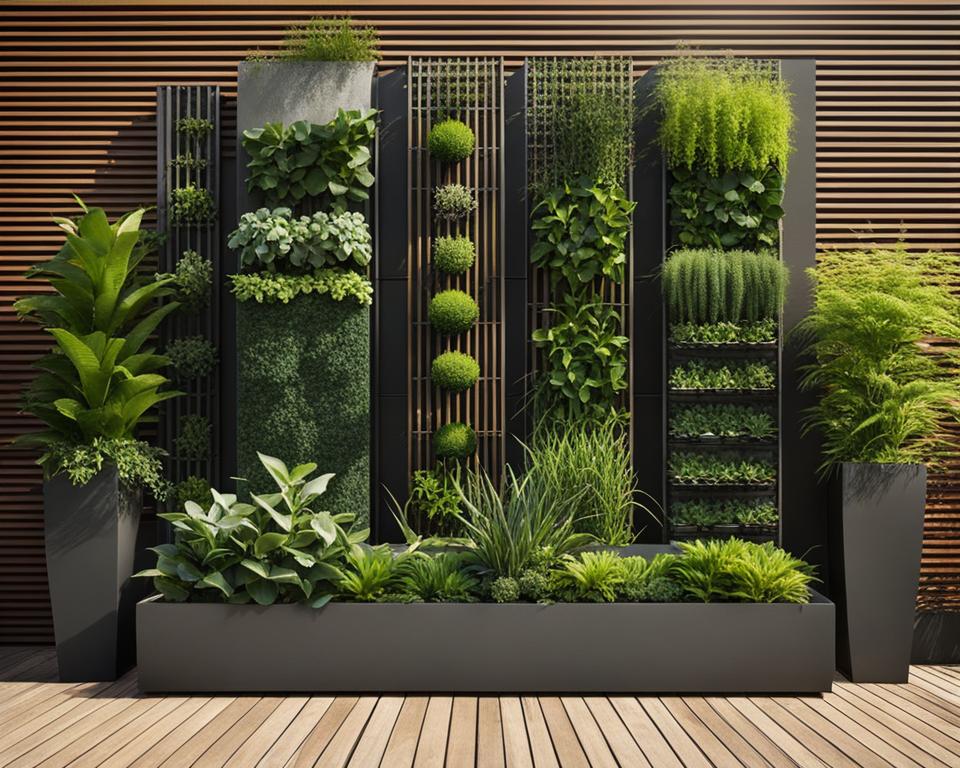As spring unfurls its green tendrils in Baton Rouge, you might find yourself eyeing the emerging verdancy with a desire to join in its splendor. Vertical gardening planters offer an elegant solution for garden enthusiasts like you looking to flourish in the realm of urban agriculture. By ushering in the practice of growing plants upwards, vertical garden planters stand as your allies in crafting a thriving garden irrespective of limited ground space. Whether it’s peppering your patio with lush flora, or creating living wall art inside your home, the art of vertical gardening is a transformative approach adaptable to both indoor and outdoor environments.
Imagine your very own vertical oasis, where conventional flower beds and maintenance give way to an upward bloom of houseplants, vegetables, and even shrubs. The unique canvas of your Baton Rouge abode becomes the backdrop for creative planters for vertical gardening. It’s time to let your gardening ambitions ascend heights you once deemed unattainable.
Key Takeaways
- Unlock the potential of small spaces with innovative vertical gardening planters.
- Vertical gardens adapt seamlessly to both outdoor patios and indoor settings.
- Explore alternative gardening by cultivating a variety of plants in vertical garden planters.
- Springtime is perfect to start vertical gardening projects that enhance your living space aesthetically and functionally.
- Embrace the creative freedom and efficiency that planters for vertical gardening bring to urban dwellers.
- Transform your Baton Rouge home into an eco-friendly retreat with lush vegetation.
The Essentials of Vertical Gardening in Small Spaces
Urban dwellers know all too well the constraints of cramped living quarters, the premium on outdoor areas, and the longing for a touch of greenery. Enter vertical gardening, a solution that marries lush foliage with spatial economy. Blessed with creatively designed best vertical gardening planters, you can forge a verdant retreat even in the tiniest of spaces. Such planters not only embellish your home but foster a hands-on, sustainable lifestyle right within your urban sanctuary.
Imagine stepping onto your balcony or patio and being greeted by walls adorned with foliage, the best vertical gardening planters brimming with a kaleidoscope of vegetation. This is not just a dream for those in Baton Rouge’s compact settings; it’s a readily attainable reality. Your vertical garden might begin with an array of vertical gardening planter ideas—from pallet gardens to tiered box planters—all smart selections for optimizing the vertical plane.
They say necessity breeds innovation, and in the sphere of vertical gardening, it sparks a variety of ingenious planter ideas. Here is a table showcasing diverse creative concepts, material choices, and planter types, each a testimony to the ingenuity that compact spaces can inspire:
| Planter Type | DIY Friendly | Suitability | Material |
|---|---|---|---|
| Wall Pocket Planters | Yes | Herbs, Small Flowers | Recycled Fabrics, Felt |
| Repurposed Bottle Gardens | Highly | Small Greens, Succulents | Plastic Bottles |
| Hanging Baskets | No | Flowering Plants, Ferns | Wicker, Metal |
| Trellis Planters | Medium | Climbers, Vining Vegetables | Wood, Metal |
| Upcycled Gutter Planters | Yes | Lettuce, Herbs | Metal Gutters |
The essence of vertical gardening planter ideas lies not solely in their aesthetic allure but in their pragmatic virtues as well. Weeding becomes less arduous with elevated planters, pests are more manageable, and harvesting is a joy rather than a chore. Indeed, your vertical garden is more than a means to grow; it’s a lifestyle, a symbol of your commitment to beauty and sustainability married harmoniously together.
Embrace the vertical and watch your gardening dreams ascend to new heights.
Choosing Plants for Your Vertical Gardening Planters
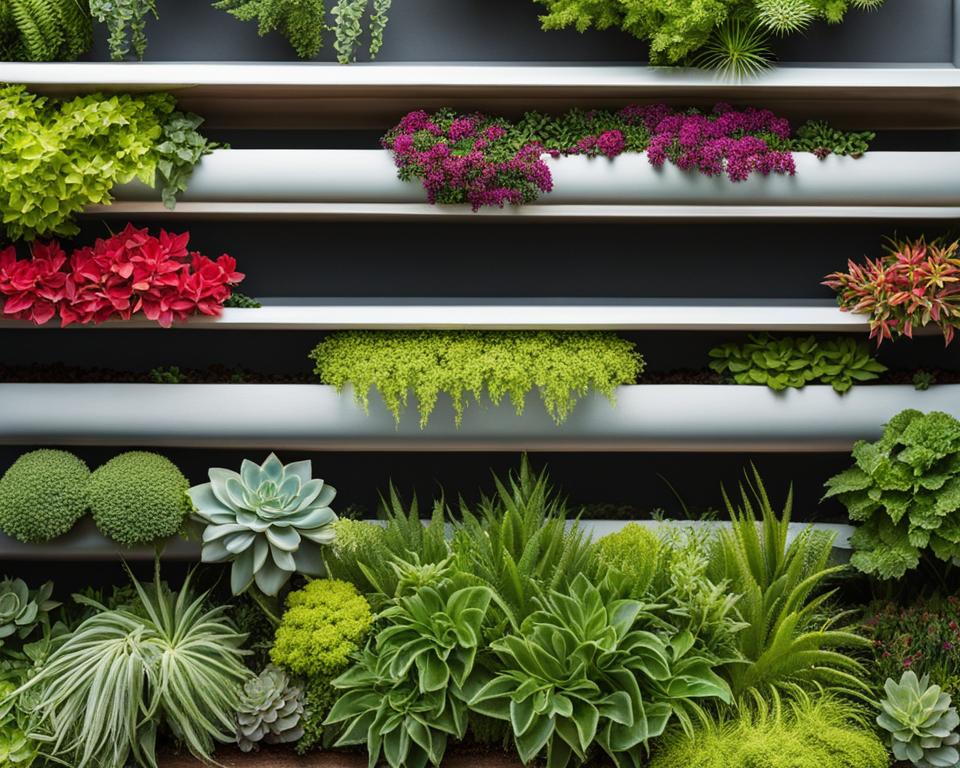
Creating a vibrant and thriving vertical garden starts with choosing the right flora to suit your vertical garden planter designs. The plants you select need not only to fulfill aesthetic desires but also to adapt well to the vertical life, ensuring your vertical garden planter boxes become lush centers of growth.
Best Plants for Vertical Growth
Gardening vertically is an art that blends horticulture with spatial innovation. Your choice of plants can make all the difference, with some species naturally predisposed to excel in a vertical habitat.
- For edible options, consider strawberries and salad greens, which are not just space-efficient but are also easy to harvest at eye level.
- Flowering vines like morning glories or climbing hydrangea can turn a mundane wall into a tapestry of petals and leaves.
- Cascading plants such as petunias and ivy drape beautifully over the edges of containers, adding depth and texture to your garden arrangement.
Considering Light and Water Requirements
Successful vertical gardening also means being mindful of the natural needs of your plants. Sunlight and water are the lifeblood of your vertical garden, and understanding these requirements is key to any flourishing green space.
| Plant | Light Needs | Water Needs |
|---|---|---|
| Strawberries | Full sun | Consistent moisture |
| Salad Greens | Partial to full sun | Regular watering |
| Morning Glories | Full sun | Moderate, well-draining |
| Climbing Hydrangea | Partial shade to full sun | Moist, well-draining |
USDA Hardiness Zones and Plant Selection
When planning your vertical garden, it’s essential to consider your region’s climate. The USDA Hardiness Zones provide a reliable guide to determining which plants will thrive in your locale. Baton Rouge, for instance, falls within zones 8b to 9a, making it suitable for a wide variety of plants that can tolerate mild winters and hot summers.
Remember that the right plants and care tailored to your environment will lead to a luxe and robust vertical garden, a peaceful and productive sanctuary in your own home.
DIY Vertical Gardening Planters for Baton Rouge Residents
Living in Baton Rouge offers an excellent opportunity to get creative with your green space. DIY vertical gardening planters are a fantastic way to integrate nature into your home, no matter the size. Whether you’re looking to grow luscious strawberries or a versatile selection of herbs and greens, the possibilities are endless with some imagination and a bit of handiwork.
Imagine transforming a bland PVC pipe into a thriving strawberry tower or turning old gutters into a bountiful lettuce garden. These are not just thrifty solutions but also highly efficient for Baton Rouge residents looking to save on space while growing their food or flowers. One of the many benefits of vertical wall planters is the touch of personal flair they can add to your outdoor areas. From hanging colorful buckets to crafting your trellis out of recycled materials, DIY projects like these empower you to personalize your space uniquely.
With just a few supplies, a clear picture of your garden goals, and a dash of creativity, you can have your vertical garden up and running in no time. And the best part? You’re limited only by your imagination. Greens growing vertically in Baton Rouge’s sunshine not only provide function and beauty but also contribute to sustainability by repurposing materials that would otherwise go to waste.
- Upcycle with Purpose: Transform everyday items into garden features.
- Space Optimization: Make the most of Baton Rouge’s urban landscapes with innovative planter solutions.
- Customized Agriculture: Tailor your vertical garden to fit your unique taste and outdoor space.
Embrace the art of vertical gardening and see how your Baton Rouge home can flourish with these DIY vertical gardening planters that defy conventional green spaces. Your walls can bloom with beauty, your palate can rejoice with fresh harvests, and your heart can swell with pride at the sight of your handcrafted vertical oasis.
Designing Your Vertical Garden: Concepts and Styles
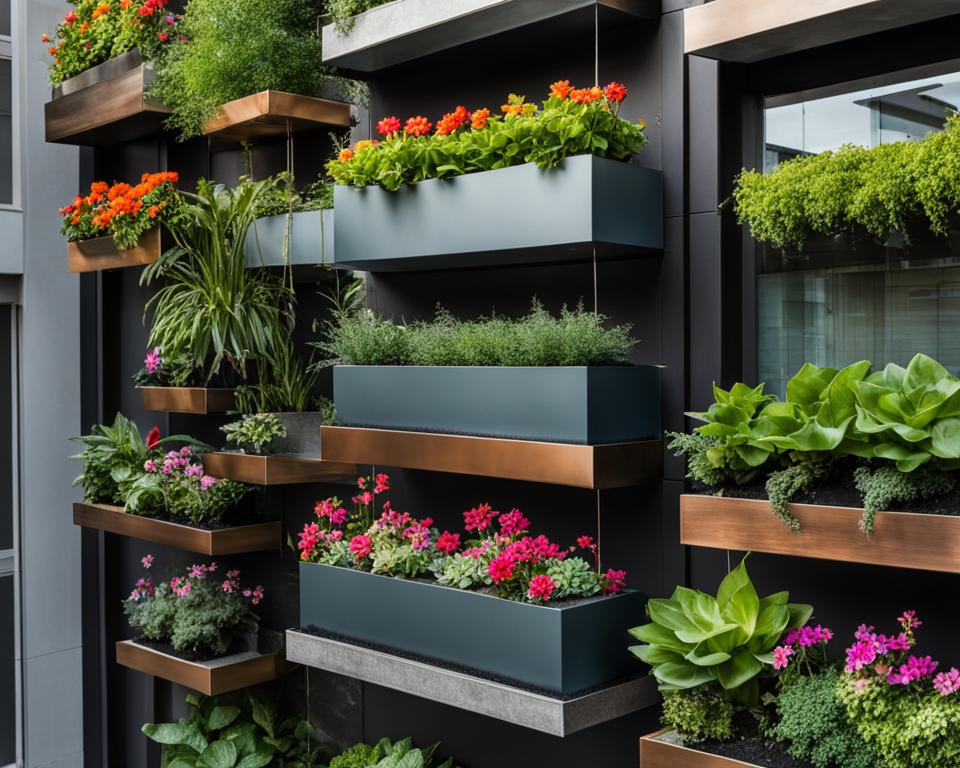
Bring a touch of nature to your urban abode by masterfully designing a vertical garden that maximizes your sparse wall space. You have the freedom to transform any plain exterior into a vibrant living wall. Embrace the trend of hanging vertical planters, one of the most visually striking and space-efficient ways to breathe life into your urban garden.
Utilizing Wall Space in Urban Gardens
With square footage at a premium in city settings, vertical gardens serve as green oases in concrete jungles. Hanging planters provide an ingenious solution for elevating foliage without encroaching on the limited floor area, turning walls into lush tapestries of green that also contribute to temperature regulation and biodiversity.
Creating a Focal Point with Vertical Elements
Vertical structures like trellises or modular planting systems don’t just offer practical benefits; they become the cornerstone of your garden’s look. A carefully placed arrangement of hanging planters, with vibrant colors and textures, draws the eye and centers your space. This central feature can become the heart of your garden, around which all other elements revolve.
Integrating Artful Aspects into Garden Designs
Think of a vertical garden as a canvas for your creativity. The architectural elements of your residence, along with the natural fluidity of plant life, allow you to integrate art directly into the environment. Use hanging vertical planters to create patterns or a riot of colors that capture the imagination and enchant the senses, proving that function and form can coexist beautifully in your garden.
Maximizing Yields: Tips and Tricks for Vertical Gardening
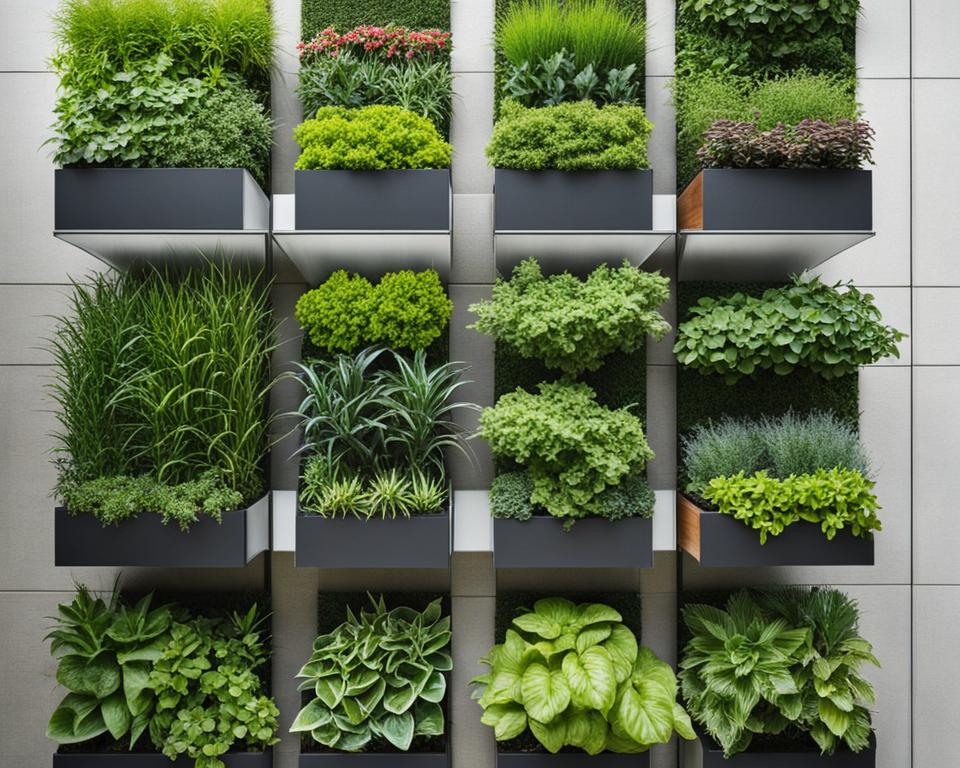
If you’re a Baton Rouge gardener looking to make the most of your vertical garden planters, a few clever strategies can help boost your plant productivity. Understanding how to effectively utilize your space is key to reaping a bountiful harvest, even when your gardening footprint is limited to a small balcony or wall.
First, assess the sun’s path across your garden space to optimize the placement of your planters for maximum sunlight exposure. Observe where light is most abundant at various times of the day and align your planters to benefit from these bright spots. This simple step can dramatically improve plant growth.
By choosing climbing and vining plants, you turn the vertical dimension into a canvas for luscious growth, letting plants like cucumbers, tomatoes, and beans rise towards the sun.
- Consider classic climbers such as pole beans and indeterminate varieties of tomatoes.
- Install sturdy supports like trellises or netting to help guide their growth.
Additionally, tiered planting is not just a visually captivating arrangement; it’s a way to create a symbiotic environment where each plant contributes to the well-being of its neighbors. You might place herbs that deter pests near the base of the planters, while vegetables that need more sunlight occupy the top tiers.
- At the lowest level, aromatic herbs can ward off unwanted insects.
- Mid-tier levels are perfect for shade-tolerant greens like lettuce or spinach.
- The topmost tiers should be reserved for sun-loving fruits and flowering plants.
The benefits of strategic planting are manifold, offering not just a method to maximize yields but also imbuing your garden with a natural, aesthetic appeal. Leverage these tips, and soon your vertical garden planters will be brimming with vibrant life and delectable produce ready for your table.
Structural Components of Vertical Gardening Planters
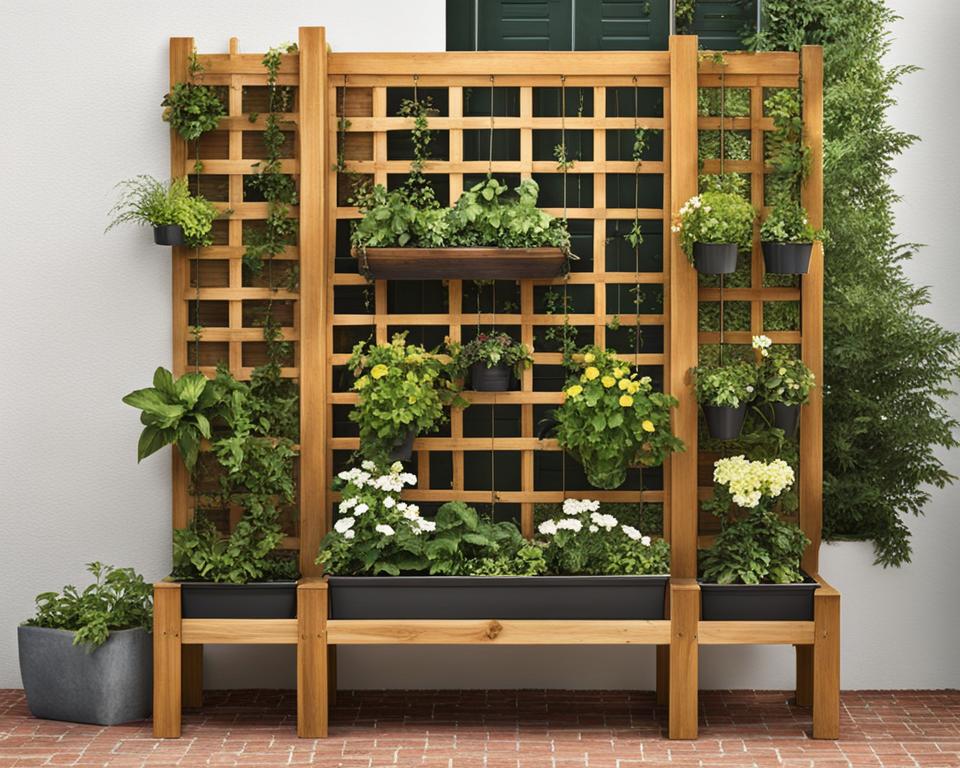
When considering the success of your vertical gardening endeavors, the structural components play a pivotal role. Not only do they provide the necessary support for your soaring plants, but they also contribute to the overall health and productivity of your garden.
Trellises and Their Advantages
Choosing a sturdy trellis is essential when creating vertical gardening planters. These frameworks, made from materials like resilient metal poles or natural bamboo, are ideal for supporting the weight of hearty climbers, such as watermelon vines to the more delicate tendrils of sweet peas.
- Easier harvesting due to elevated growth
- Improved air circulation around plants, which reduces disease risk
- Better exposure to sunlight, which can lead to more fruitful yields
Gutters and Bottle Gardens: Repurposing with Purpose
The ingenuity of vertical gardening is showcased when everyday items are repurposed into thriving plant habitats. Gutters, often discarded or replaced, find new life as linear planters perfect for herbs and lettuce. Similarly, plastic bottles, which would otherwise contribute to waste, can transform into self-watering planters, adding a touch of upcycled charm to any space.
| Material | Benefits | Ideal Plants |
|---|---|---|
| Gutters | Long, continuous growth space | Herbs, strawberries, salad greens |
| Bottle Planters | Water-efficient and self-draining | Succulents, small flowers, ivy |
Both trellises and repurposed containers not only serve functional roles in vertical gardening planters but also display the innovation and eco-consciousness that urban gardening promotes. By elevating your garden, literally and aesthetically, you create a thriving space that benefits both the environment and your well-being.
Innovations in Vertical Gardening: Hydroponics and Automatic Systems
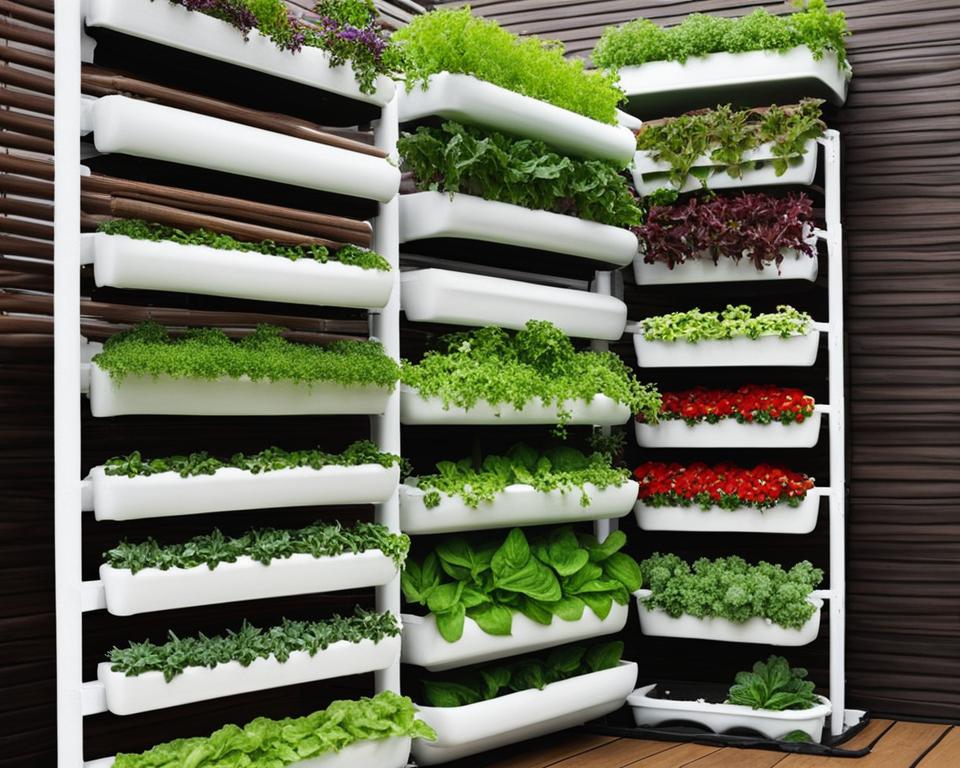
The realm of vertical gardening planters has greatly evolved with the adoption of advanced techniques such as hydroponics and automated watering systems. Imagine nurturing a thriving garden with minimal soil or even soil-free methods. Hydroponic living walls represent the pinnacle of efficiency in urban gardening, allowing you to cultivate a variety of greens and flowers within the bustling city of Baton Rouge.
With these innovative gardening systems, the complexity and time typically associated with plant care are significantly reduced. Automated systems take the guesswork out of watering, supplying your vertical gardening planters with optimal moisture based on the needs of each specific plant. The hydroponic approach not only saves valuable resources but promotes robust plant growth by delivering nutrients directly to the roots.
Let’s delve deeper into the benefits:
- Cleaner gardening without the mess of soil.
- Less water usage, as hydroponic systems recycle water efficiently.
- Better control over nutrient delivery and pH levels.
- Greater yields in a smaller footprint – ideal for Baton Rouge’s urban dwellers.
- Reduced risk of pests and soil-borne diseases.
These innovative vertical systems embody the future of gardening—where technology meets tradition to create lush, bountiful gardens in the smallest of urban spaces. By incorporating hydroponics and automated systems into your gardening practice, you are equipping your vertical gardening planters with the means to not only survive but thrive in the modern age.
Caring for Your Vertical Garden: Maintenance and Sustenance
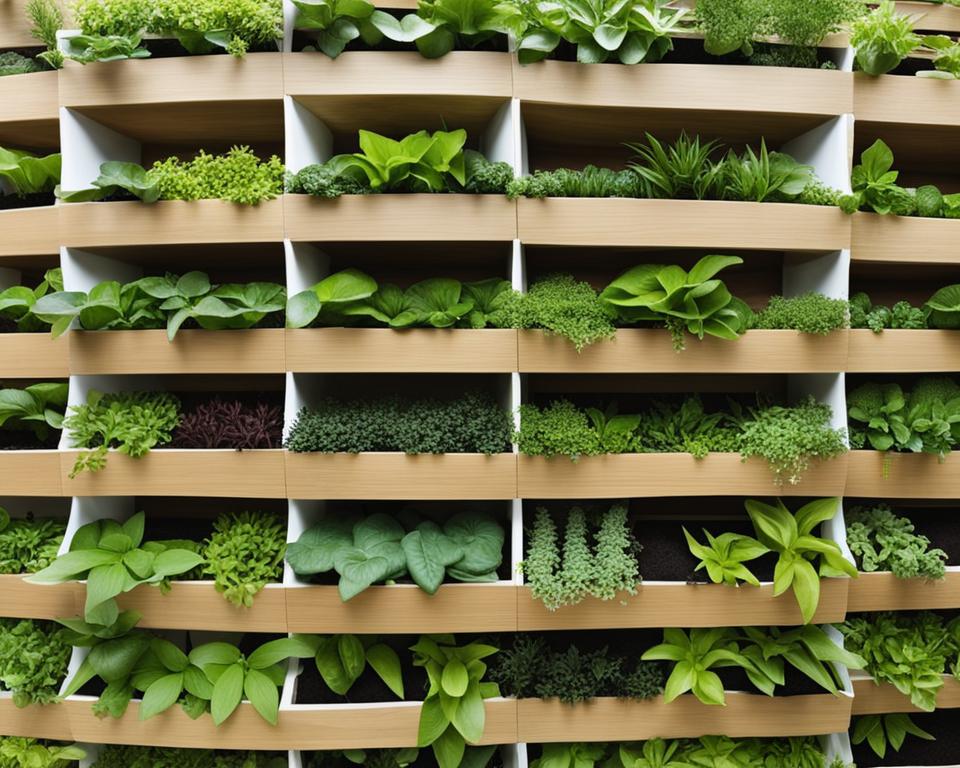
Maintaining your vertical gardening planters is not only crucial for the plants’ growth but also for prolonging the life of your garden’s structure. A well-maintained vertical garden ensures a fruitful harvest, a vibrant display, and a rewarding gardening experience. Here, we delve into the maintenance practices that will help your vertical garden thrive in Baton Rouge’s unique climate.
Water Management: Irrigation and Drainage
Effective water management is the cornerstone of a flourishing vertical garden. Proper irrigation ensures your plants remain hydrated without excess water that could lead to root rot or fungal diseases. Consider drip irrigation for efficient water delivery straight to the roots. Drainage is equally important as it prevents over-saturation of the soil, which could damage the plant and the integrity of the planters. Install drainage systems that allow excess water to flow away from the plants, ensuring that each one receives just the right amount of moisture to thrive.
Disease and Pest Control in Vertical Spaces
Vertical gardens are not immune to the pests and diseases that plague traditional gardens, but their unique structure can sometimes make them more susceptible if not carefully monitored. Regular inspections for signs of insects or disease help prevent outbreaks that can spread rapidly in the close quarters of a vertical arrangement. Use organic pesticides when necessary to manage pests without harming beneficial insects or the environment. Implementing companion planting can also deter pests naturally, creating a harmonious and balanced ecosystem within your vertical space.
Seasonal Adjustments and Plant Rotation
With Baton Rouge’s varying climate, it’s essential to adapt your vertical gardening planters to changing seasons. Rotate out plants that are past their prime and replace them with seasonally appropriate varieties that will prosper in the current conditions. This not only maintains the aesthetic appeal of your vertical garden but also encourages continuous productivity. Seasonal adjustments, when planned well, can provide a year-round bounty of vegetables, herbs, or flowers, keeping your garden lively regardless of the season.
Remember, the key to a thriving vertical garden is regular maintenance and a careful eye. Your efforts will be rewarded with a vibrant and productive vertical garden that brings beauty and bounty to even the smallest of spaces.
Conclusion
As we wrap up our comprehensive guide, it’s evident that vertical gardening planters offer a world of possibilities to Baton Rouge residents and gardeners everywhere. Whether you’re dealing with the spatial restrictions of urban living or simply seeking a new gardening challenge, vertical garden planters provide a pathway to not only enhance your living space but also to contribute to the well-being of our environment.
Key Takeaways for Aspiring Vertical Gardeners
Your journey into vertical gardening, supported by the right planters and knowledge, can turn any blank wall or bare balcony into a lush, vertical oasis. Remember, the key to success lies in choosing the right plants, understanding their needs, and ensuring they are matched to your local climate conditions. Boldly turn your vertical spaces into productive edible gardens or aesthetic features, knowing that every plant you grow upwards is a step towards a greener, more vibrant home.
The Environmental Impact of Vertical Gardening
Moreover, the environmental impact of integrating vertical gardening into your urban landscape cannot be overstated. By reducing the urban heat island effect and enhancing urban biodiversity, vertical gardens play a crucial role in promoting sustainability. They’re not just a stylistic choice; they represent a meaningful commitment to ecological stewardship. Vertical gardening is an empowering act, allowing you to harvest fresh produce and enjoy tranquility while making a positive impact on the world around you.
FAQ
What are the benefits of vertical gardening planters?
Vertical gardening planters allow you to maximize your growing space, particularly beneficial in urban areas with limited yard space. They can improve the aesthetic of your environment, ease the maintenance of plants, and can be utilized for a variety of houseplants, vegetables, and flowers. Additionally, they provide environmental benefits by promoting biodiversity and reducing urban heat.
What are some creative ideas for DIY vertical gardening planters?
DIY vertical gardening planter ideas include using repurposed gutters, PVC pipes, wooden pallets, plastic bottles, or hanging buckets. Each of these can be converted into space-saving planters for your garden, deck, or balcony, adding a unique and personal touch to your space.
What plants are best suited for a vertical garden planter?
Ideal plants for vertical garden planters include flowering vines like morning glories, vegetables such as strawberries and salad greens, and a variety of herbs. Climbing plants that can take advantage of vertical growing space, such as climbing hydrangea, are also excellent choices.
How should I consider light and water requirements when designing vertical garden planter boxes?
When designing vertical garden planter boxes, it’s essential to consider the amount of sunlight the area receives and to select plants with compatible light needs. Moreover, ensuring proper water drainage and installing an efficient irrigation system can help maintain the health of your vertical garden.
Why are trellises advantageous in vertical gardening?
Trellises provide structure and support for climbing plants, allowing them to grow upwards rather than spreading out. This not only saves space but also can result in healthier produce by improving air circulation and reducing disease. Materials like metal poles and bamboo are common choices for trellis construction.
How do innovations like hydroponic systems and automated watering systems impact vertical gardening?
Hydroponic systems allow plants to grow without soil, which can lead to a cleaner and more efficient growing process. Automated watering systems ensure that plants receive the precise amount of water they need, simplifying maintenance and increasing the likelihood of a successful vertical garden.
What are some maintenance tips for vertical gardening planters?
Key maintenance tips for vertical gardening include regular watering, ensuring proper drainage, pest and disease control, and making seasonal adjustments to plant rotations. Additionally, maintaining the structural integrity of supports like trellises is crucial for long-term success.
How does vertical gardening contribute to the environment?
Vertical gardening contributes to the environment by increasing green spaces in urban settings, supporting biodiversity, and reducing the urban heat island effect. It’s also a form of gardening that can encourage the use of recycled materials and reduce the overall environmental footprint.

